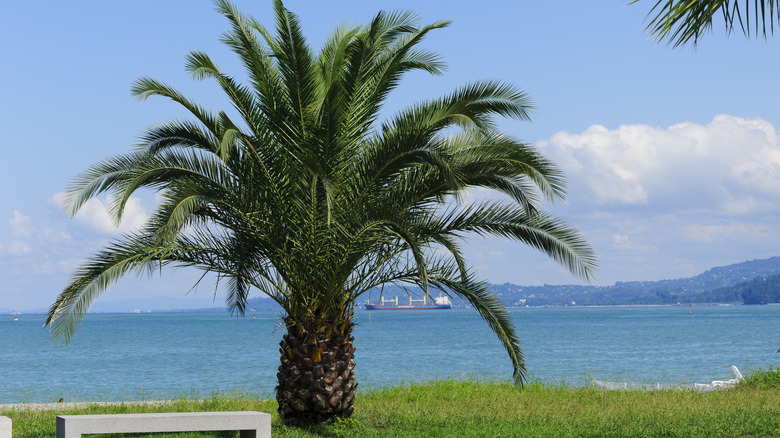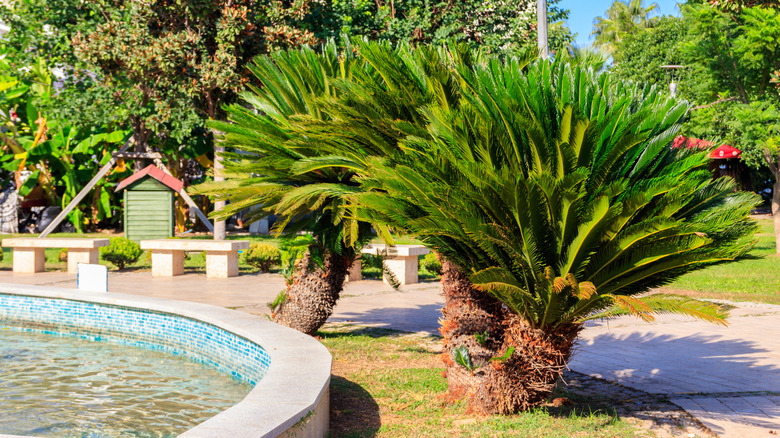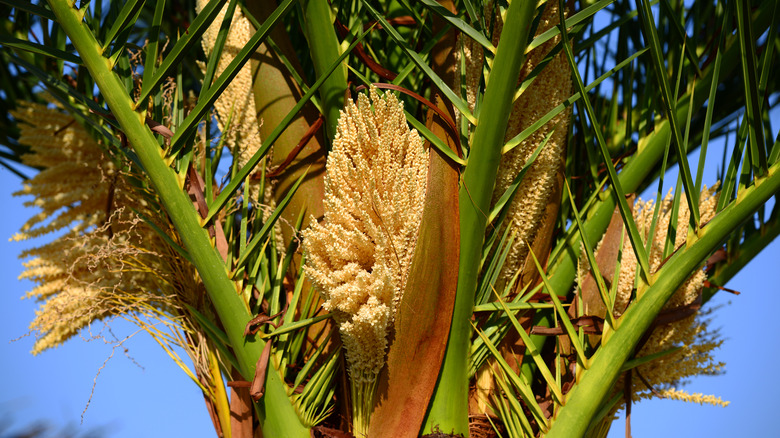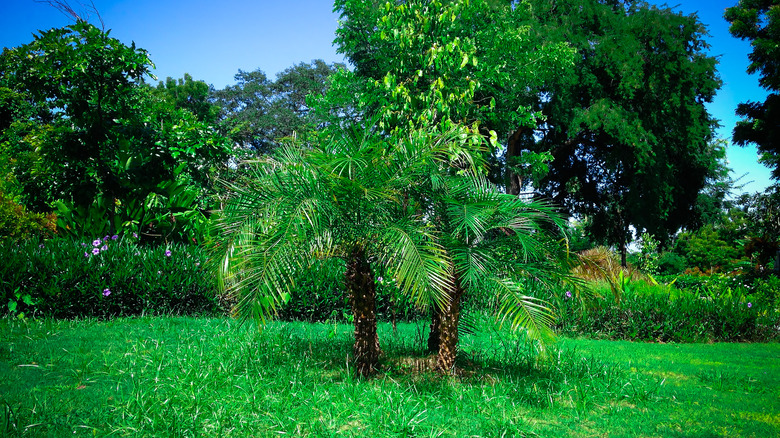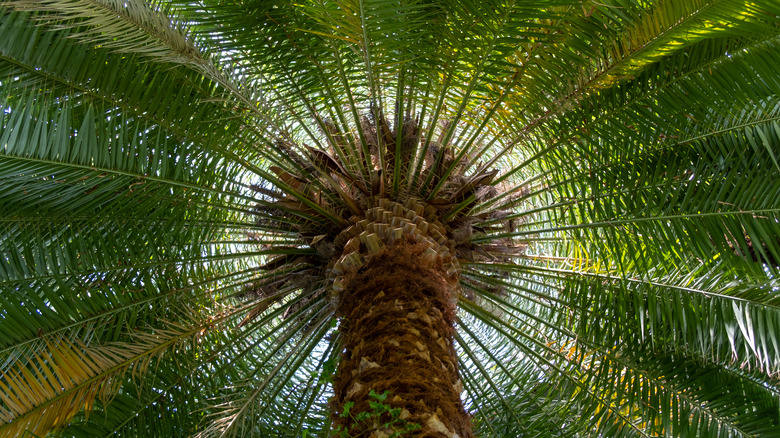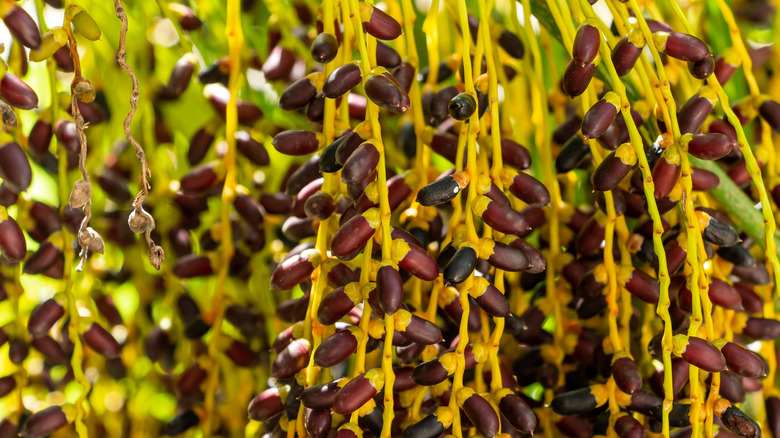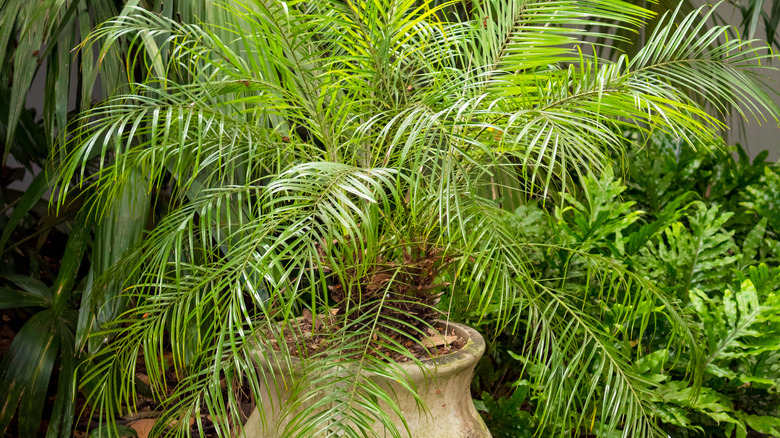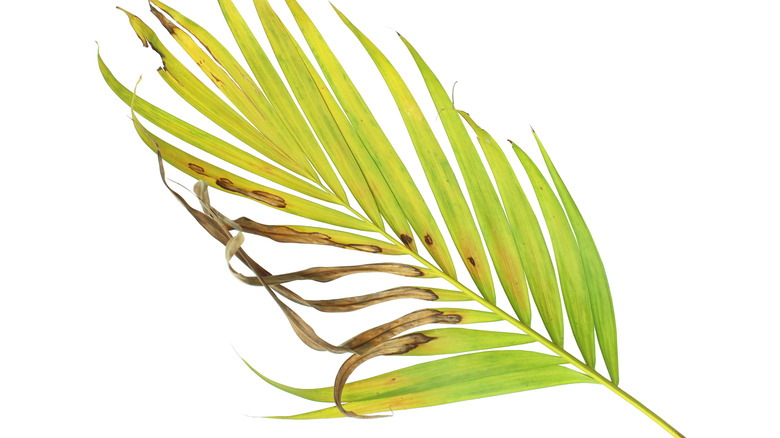How To Grow And Take Care Of A Pygmy Date Palm Tree
Phoenix roebelenii, the pygmy date palm, is a dioecious species of palm tree native to Southeast Asia. Due to suitable weather conditions, it has become a very popular choice amongst landscapers in areas like Florida, Arkansas, Southern California, and Texas. Dioecious describes any plant that is either a male or a female, where neither can create fertile seeds on its own. Instead, pollen from the males must be carried by wind, bird, bee, or other pollinators to the female tree.
As its common name suggests, Phoenix roebeleni is a pygmy variety of the true date palm, which towers up to 40 feet high. Much smaller in scale, the pygmy variety will grow to a maximum of 12 feet, often topping out closer to 10 feet. Per All About Palm Trees, off-white flowers bloom in spring and yield clusters of fruit in the fall. The small fruit produced on the pygmy is nowhere near as fleshy or sweet tasting as the delicious dates we're accustomed to finding at the market; however, they are still edible.
How to use a pygmy date palm tree in the garden
Palm trees can grow incredibly high, making them difficult to maintain in a yard and potentially hazardous in high-speed winds. The opposite characteristics account for the enormous popularity of the pygmy variety. Pygmy palms stay compact and lower to the ground, yet they have the same beautiful fronds that evoke the relaxing vibes of the tropics. They look great planted in small groupings or used to line walkways in a landscape. These trees like moisture, so planting them near a water feature is also a good idea. Phoenix roebelenii trees are cold hardy down into the 20s degrees Fahrenheit, but they still need a general year-round environment of warmth and high humidity. Ultimately, they are not good for cold areas because even though they can do well in containers, they'll be too big to easily relocate. If you live somewhere that only occasionally gets too cold, Texas Riviera offers tips on temporarily insulating and protecting your vulnerable trees with wool blankets, tarps, and bungees.
Pygmy date palms should not be confused with their close cousins, dwarf date palms. Pygmies have above-ground trunks that lift the palm fronds up and away from the soil. Dwarf date palms have subterranean trunks, which place the base of the fronds at ground level. Dwarf variety trees will not grow large enough to flush out a landscape design, but they may do well decoratively placed within a succulent garden.
How to grow a pygmy date palm tree
Pygmy date palms grow well from seeds. The first step is to harvest the fruit when it is the ripest, to the point of starting to wrinkle. Give each fruit a squeeze to release the interior seed, then wash the seeds vigorously and soak them overnight. Before planting, SFGate recommends using an insecticidal powder to ensure the seeds are free of harmful pests that could stunt their progress. They'll have the best chance in a mix of potting soil and sand that is kept warm — a heating pad placed underneath will do the trick.
The seeds can stay pretty shallow; no need to press them too deep into the growing medium when planting. To help retain moisture and warmth, spread a thin layer of sand over the top of the soil. Finally, find your seed trays a bright spot and use a spritzer bottle to water them, so you don't risk flooding the pots and washing the seeds away. Now, settle in and wait. Germinating or sprouting can take up to three or four months, and there's nothing to do but give them time. When the seedlings reach a few inches high, they'll be ready for transplanting into larger grow pots.
How to care for a pygmy date palm tree
Sun exposure, high temperatures, and humidity are the three key factors in taking good care of a pygmy date palm tree. Consistently scheduled watering is necessary for optimal growth and overall health as well. Consider installing a basic irrigation system if you live in a drier area. In their native regions, pygmy date palms are often found growing in clusters close to or alongside riverbanks, so another option for a novice landscaper is to plant your palm trees near a pond or artificial water feature.
Gardening Know How suggests pruning to maintain your tree's shape and removing damaged palm fronds. This should remain a manageable task for the tree's life, given its size. Gloves are recommended when pruning and ensure to maneuver around the spiky thorns you'll find on the leaf stalks. Since these trees propagate via seed, it will behoove you to keep the area below your pygmy palms free from fallen debris. Otherwise, you may soon find yourself pruning back an entire grove instead of a small cluster.
Pygmy date palm tree varieties
Date palms as a group are also referred to as Phoenix palms. This brings us back to the genus Phoenix, within which there are less than 20 species. All date palms are dioecious (either a male or female plant incapable of seeding without pollination) and have pinnate (feather-shaped) fronds. As for height, these few species together encompass a range of 12 inches to 60 feet. California-based nursery Jungle Music specializes in palms and considers the following varieties among the most popular of the Phoenix dates.
- Phoenix dactylifera — This is the true date palm and the only variety commercially grown for its fruit.
- Phoenix Canariensis — Named for its native home, the Canary Islands, this is the largest variety of Phoenix palm growing up to 60 feet tall with 15-foot-long fronds.
- Phoenix rupicola — The cliff date palm can be found at high altitudes in India. Its fronds have a flowy feel and a deep green glow.
- Phoenix reclinata — The Senegal date palm is a high-maintenance variety native to Africa. Sometimes compared to coconut palms, the trunks of these trees will occasionally grow upwards in the shape of a curve beckoning the true energy of the islands.
- Phoenix acaulis — The true dwarf variety smaller than the pygmy, this tree has a trunk that remains underground.
Is the pygmy date palm toxic?
Pygmy date palms are considered non-toxic, meaning it's safe for you to grow them in a yard frequented by pets and children. In fact, the fruit is deemed safe for consumption. These small dates arrive after the tree has flowered; they start off reddish-brown and then turn black as they ripen. Just like the tree itself, the pygmy dates are miniature versions of the larger dates we know well.
So, what then do the pygmies taste like? Lucky for us, the fine folks over at Eat Your Backyard, have added them to their Central Florida backyard fruit and vegetable permaculture food forest, and they've done a video taste test. The verdict is far from flattering: Edible, yes, although not particularly tasty, and certainly not as plump or sweet as the dates produced by larger date palms. If you want to try some pygmy dates yourself, the best time to eat them is when they are super ripe and wrinkly. If you're concerned that your gluttonous canine or feline has gone a little overboard in the tasting department, keep an eye out for mild tummy upset. But don't worry too much as symptoms should clear quickly.
How to repot your pygmy date palm
Just as you would when pruning, you'll want to wear protective gloves and keep a close eye out for those thorns when it's time to repot your pygmy date palm. Ceramic or concrete containers will provide sufficient base weight and support for a tree that will grow to become top-heavy. Unfortunately, they'll also make your plants incredibly heavy and difficult to move, so find your placement and do the necessary work there to avoid the hassle later.
Overall, these pygmy trees are slow growers, so repotting is not a task you'll need to do often. Guide To Houseplants advises that once every few years should suffice. Spring is the season to do so, as this will set your young tree up for a healthy growing season. As the plant matures into its largest container, the guide offers a tip for topdressing the soil instead of continuing to repot. Topdressing simply means gently removing a few inches of soil from the top of the container and replacing it with fresh, nutrient-dense soil. A compost blend with fertilizer will also help your tree thrive.
Nutrient deficiency in pygmy date palm trees
Pygmy date palms are considered disease- and pest-resistant; however, they do sometimes suffer from nutrient deficiencies. University of Florida's IFAS Extension has isolated potassium, magnesium, manganese, and boron deficiencies as the most common problems, each presenting as a specific discoloration in the leaves. Low potassium levels will damage leaf tips and cause whole leaves to turn yellow/orange and fall off prematurely.
If your soil is low in magnesium, you'll see a wide band of yellow cover the edges of the leaves while the centers remain green. Manganese deficiency occurs in soil that has become too alkaline. In this case, the black streaks that appear are necrotic. In time, the leaves will curl up and dry out. In all cases, specifically formulated fertilizers should be able to get your deficient trees stable and healthy again. Talk to the experts at your local garden center for the best advice.
